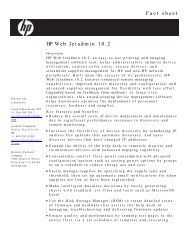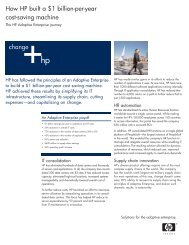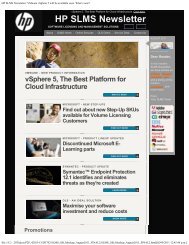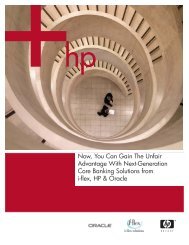CIMdata review on SAP's PLM cPDm program (PDF) - Large ...
CIMdata review on SAP's PLM cPDm program (PDF) - Large ...
CIMdata review on SAP's PLM cPDm program (PDF) - Large ...
You also want an ePaper? Increase the reach of your titles
YUMPU automatically turns print PDFs into web optimized ePapers that Google loves.
Significant features are available in three areas of<br />
ECN, namely effectivity parameters, release keys, and<br />
change hierarchies.<br />
Effectivity Parameters – An ECN supports effectivity<br />
based <strong>on</strong> date, serial number, or any other c<strong>on</strong>figurable<br />
parameter (e.g., "customer number," "airline name,"<br />
etc). The provisi<strong>on</strong> of parameter-based effectivity is<br />
important as it enables the validity of an object to be<br />
based <strong>on</strong> <strong>on</strong>e or more attribute values.<br />
Release Keys – By using a release key <strong>on</strong> an ECN, it is<br />
possible to individually release changes to enable, for<br />
example, simulati<strong>on</strong>, costing, planning, and producti<strong>on</strong><br />
to be carried out without having to wait for the complete<br />
product structure to be released. This capability is useful,<br />
for example, when the change in questi<strong>on</strong> has no<br />
impact <strong>on</strong> procurement or producti<strong>on</strong>, yet may take a<br />
l<strong>on</strong>g time before all objects in the product structure<br />
have been checked, modified, and released.<br />
Change Hierarchies – These can be used to ease the<br />
structuring of dependent ECNs. A change hierarchy is<br />
defined by a "change leader," which is made up of multiple<br />
"change packages." These change packages can<br />
represent technical or organizati<strong>on</strong>al issues. The change<br />
leader c<strong>on</strong>trols the release of all subordinate change<br />
packages. Therefore, it is possible to ensure the comm<strong>on</strong><br />
release of dependent changes for producti<strong>on</strong>.<br />
The ECN c<strong>on</strong>trols changes to documents, parts (material<br />
masters), BOMs, routings, plans, classificati<strong>on</strong>,<br />
and c<strong>on</strong>figurati<strong>on</strong> profiles.<br />
mySAP <strong>PLM</strong> uses a status<br />
system for c<strong>on</strong>trolling the change<br />
management process. Status ranges<br />
can be c<strong>on</strong>figured for each<br />
document type as well as an unlimited<br />
number of status values.<br />
For a given document type, this<br />
implies that a specific set of<br />
status levels apply. These status<br />
levels can be used within the<br />
c<strong>on</strong>text of the workflow to<br />
determine how the document is<br />
processed. Change management<br />
functi<strong>on</strong>s are c<strong>on</strong>trolled in<br />
mySAP <strong>PLM</strong> through the user's<br />
authorizati<strong>on</strong> profile. Additi<strong>on</strong>ally,<br />
digital signature can be used for<br />
each approval activity. This<br />
restricts access to users in the<br />
appropriate authorizati<strong>on</strong> group to promote a change to<br />
its next state.<br />
mySAP <strong>PLM</strong>'s ECM functi<strong>on</strong>ality is a specific implementati<strong>on</strong><br />
of a change management philosophy. While<br />
we would not expect this to fit all organizati<strong>on</strong>s perfectly,<br />
it does provide a good starting point for most<br />
implementati<strong>on</strong>s, and a number of good templates are<br />
provided from which more elaborate workflows can be<br />
c<strong>on</strong>structed. mySAP <strong>PLM</strong> workflow provides the ability<br />
to versi<strong>on</strong> c<strong>on</strong>trol tasks, processes, and the workflows<br />
themselves. This is important, as many companies will<br />
wish to phase out processes and procedures, and introduce<br />
new <strong>on</strong>es to keep pace with their changing business<br />
models and organizati<strong>on</strong>al structures. Many<br />
<strong>cPDm</strong> soluti<strong>on</strong>s also allow revisi<strong>on</strong> c<strong>on</strong>trol to be applied<br />
to workflows. This is an important area that SAP<br />
should c<strong>on</strong>sider and we would recommend that mySAP<br />
<strong>PLM</strong> be further developed to include this feature.<br />
Many <strong>cPDm</strong> soluti<strong>on</strong>s claim to support impact analysis<br />
capabilities. This supports the ability to determine<br />
which documents, CAD files, specificati<strong>on</strong>s, etc., are<br />
affected by a potential change to a given item (i.e.,<br />
document, part, etc.). The benefits of this are significant.<br />
However, where many <strong>cPDm</strong> soluti<strong>on</strong>s fall short<br />
is in their inability to identify the commercial and<br />
manufacturing documents (e.g., sales orders, purchase<br />
orders, producti<strong>on</strong> orders, and routings) as these are<br />
traditi<strong>on</strong>ally managed and maintained in ERP systems.<br />
Figure 9-Order Change Management (OCM)<br />
<str<strong>on</strong>g>CIMdata</str<strong>on</strong>g> Program Assessment SAP’s mySAP <strong>PLM</strong> Page 21
















